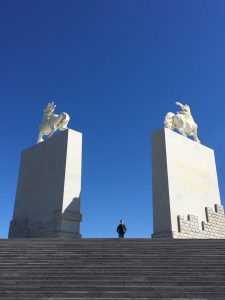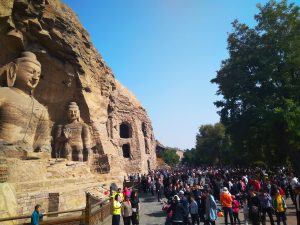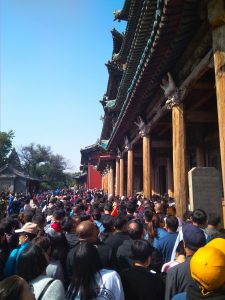10月1 号是中国的国庆节。为了欢度人民共和国的成立,大家都放七天的假,称为‘黄金周’。 我本来以为这个假期是一个会很好机会探索有些的中国远近驰名的景点,可是跟我的北京大学的中国的朋友聊天儿以后,快快地了解这个假期不是那么 轻松的!来到最受欢迎的地方的火车票几乎都卖光了,再说在名胜古迹里的人太多了。

Huge statues at Genghis Khan Mausoleum
因此,我和我的朋友决定去内蒙古。我从来没去过可是我很盼望探索鄂尔多斯:表面上,鄂尔多斯是一个比较奇怪的选择因为呼和浩特、草原、沙漠都是更有名的:可是由于两个原因而我们决定去这儿:首先,成吉思汗陵落坐落鄂尔多斯的南边。成吉思汗陵是蒙古文化的核心:虽然成吉思汗不埋葬在这儿,这个衣冠冢让我们理解成吉思汗的人生和古老的蒙古文化。

Getting away from the hustle and bustle of Beijing
其次,鄂尔多斯算是中国最荒凉的鬼城。15年以前,中国政府期望很多来自于中国的别的地方的移民移动到鄂尔多斯安顿不过他们还没前来。有巨大的大厦、精致的公园、非常宽的街道,可是人特别少,尤其是外国人 (除了自己以外,一个外国人我们都没看到)。逛逛在街道上,本地人都盯我们。在公交车站等候车,跟所有的好奇的陌生人聊天儿 – 让我中文进步得很快因为他们的口音跟北京人的完全不同!有趣的是,代沟是很明显的。对于四十岁以上的人,我们听不懂他们说的话,他们也听不懂我们。但对于比较年轻人,比较容易。
另外,我也决定去大同,山西县,旅游。跟鄂尔多斯相比,大同一点儿也不同。大同有悠久历史:悬空寺、云冈石窟、大同城郭,这些家喻户晓的景点吸引来自五湖四海的游客。可是黄金周,人山人海!比方说,在云冈石窟,由于人群,看佛教雕像的时候, 它们的宁静的脸色不反映我们!然而我还是能享受工匠的艺术人才。总而言之,黄金周以后,我感觉比以前更了解蒙古文化和在中国的佛教的重要性,而且亲身到闻名遐迩的景点是一个求之不得的机会。
ENGLISH:
The 10th October marks Chinese National Day. In order to celebrate the founding of the People’s Republic, everyone has a holiday for seven days, known as ‘Golden Week’. I originally thought that this holiday was a great opportunity to explore some of the extremely famous tourist attractions in China. However, having talked with my Chinese friends at Peking University, I quickly realised that the holiday is not actually that relaxing! The train tickets to the most popular destinations were already sold out, and besides, the amount of people in these popular destinations would be enormous.

The fantastic Buddhist statues and the accompanying crowds
Therefore, my friend and I decided to go to Inner Mongolia. I had never been before and was really looking forward to exploring Ordos. On the surface, this might seem like a rather strange choice since Hohhot, the grasslands and the desert are more famous; however, there were two main reasons why I chose it. Firstly, the Genghis Khan Mausoleum is just to the south of Ordos. This mausoleum is the core of Mongol culture and although Genghis Khan isn’t actually buried here, this cenotaph allowed us to better understand his life and the ancient Mongol culture.

人山人海… Datong: not quite as peaceful as Ordos
Secondly, Ordos is considered a ghost city. Fifteen years ago, the Chinese government expected a lot of Chinese migrants from other parts of the country to settle in Ordos, yet they never arrived. There are huge tower blocks, beautiful parks and vast streets, but so few people, especially foreigners (apart from ourselves, we didn’t see a single other foreigner!). Whilst we wandered around, the locals all stared at us. When we were at bus stations waiting for the bus, we would chat with all of these curious strangers – it made our Chinese improve a lot since their accents are completely different from Beijing residents’! Interestingly, a generation gap was clearly evident – we could not understand people over the age of about 40, and conversely, they could not understand us. However, when talking to younger people, it was (relatively) easy.
In addition, we also decided to go to Datong, Shanxi province. Compared to Ordos, Datong is completely different. Datong has an ancient history: famous attractions like the Hanging Temple, the Yungang Grottoes and Datong city walls attract tourists from all over the country. But in Golden Week that means that there are tons of tourists! For example, at the Yungang grottoes, due to the crowds, the Buddhist statues’ tranquil faces certainly did not reflect my own! It was all rather stressful! However, I could nonetheless appreciate the artistic talent of the craftsmen. In short, after Golden Week, I feel I now understand Mongol culture and the importance of Buddhism in China better than before, and to visit such famous attractions first hand was a great opportunity.
